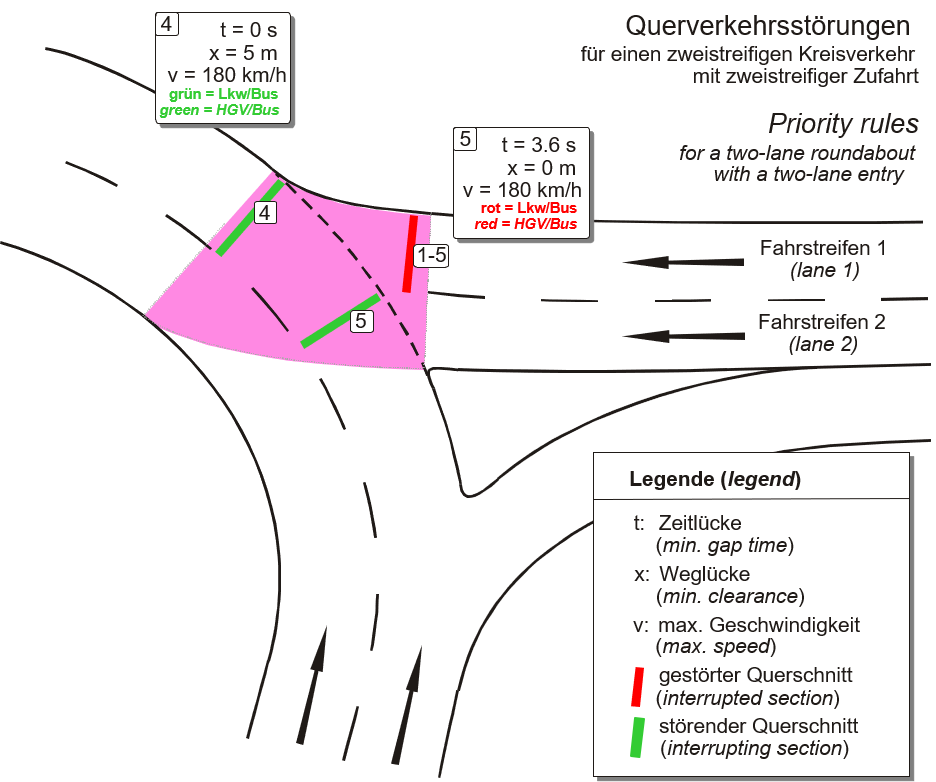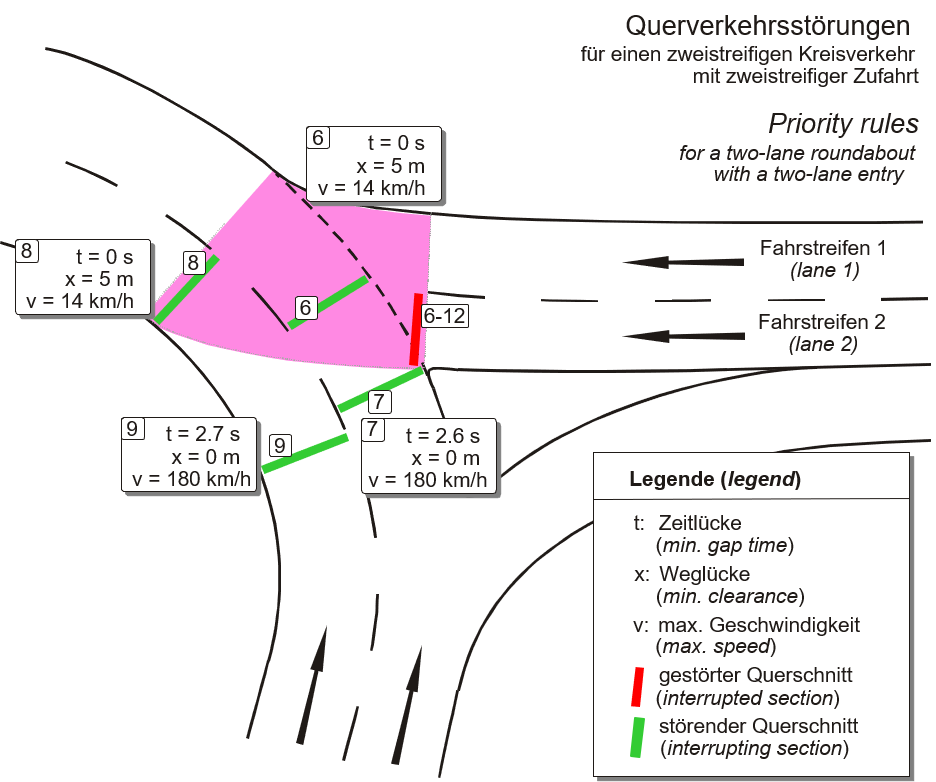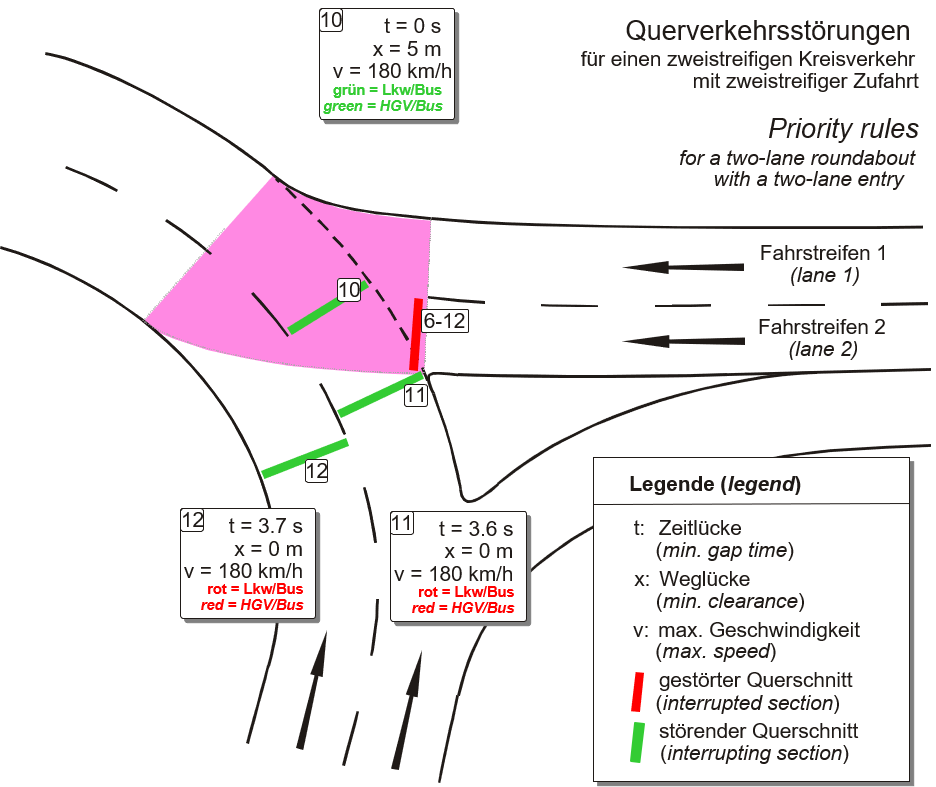Priority rule Example 3: Dual-lane roundabout with dual-lane entry
To model the entry to a roundabout, you need to specify several priority rules. They all serve different purposes. Cars, HGV and buses are treated differently on account of their acceleration capability and vehicle length. These vehicles thus have to be looked at separately.
The priority rules and their purpose are depicted in the following illustrations Step 1 to Step 4. For better understanding, you can find the numbers in the illustrations in the text. With these you can assign the associated attributes in the text. The values specified for time gap, min. clearances, and max. speed have been determined through research and thus form a realistic modeling basis for most applications.
Set the priority rules according to the following criteria:
- Position the red bar (stop line) on the stop line of the yielding road. This is the typical waiting position for vehicles. If more than one green bar (conflict marker) refers to this stop line, several green bars must be set instead of separate pairs of priority rules.
- Position the green bars which are used for the min. clearances, just before the connector turns into the roundabout lane. You thereby exclude the possibility of a yielding vehicle waiting for itself. Because of this the capacity of the roundabout would be drastically reduced.
- Position the green bars used for the time gaps at approximately the same distance from the conflict area as the respective red bars.
Step 1: Protect lane 1
Firstly, the priority rules for vehicles entering the roundabout from lane 1 are defined.

All 3 priority rules listed here refer to the same stop line. So this stop line has 3 conflict markers.
Select different positions for the time gap and min. clearance. This allows you to model a more realistic driving behavior: A vehicle driving at least 14 km/h on a roundabout will allow another vehicle to accelerate into the roundabout, even if it is still in the conflict area. This leads us to the first two priority pairs (1 and 2). They are valid for all vehicle classes.
No. 1 secures the conflict area during slow moving traffic and congestion on the roundabout (min. clearance).
No. 2 provides the conditions for a normal flow of traffic (min. gap time).
As entering vehicles on lane 1 are also affected by traffic on the inner roundabout lane, an additional priority rule with a small gap time condition (No. 3) is needed for the inner roundabout lane. This priority rule is also valid for all vehicle classes.
Step 2: Protect the HGVs against entering vehicles
So far, all priority rules have applied for all vehicle classes. When long vehicles on the roundabout cross the conflict area, it is not enough to take of the vehicles that are slower than 14 km/h. To prevent vehicles entering the roundabout from laterally colliding with an HGV, an additional priority rule (No. 4) has to be positioned at the same point as rules 1-3. This priority rule must account for long, obstructive vehicles only. In our example these are HGV and buses.
Now we only need to account for the vehicles that have a lower acceleration capability than cars. To do so, we use priority rule No. 5. Contrary to the previous priority rules, this rule needs a new, separate stop line, as it only applies for the vehicle classes HGV and bus. The stop line is positioned at the same point as rule No. 2. However, a longer gap time of 3.6 s must be specified for priority rule No. 5.

Step 3: Priority rules for the left incoming lane
As for the right lane, general priority rules are defined for all vehicle classes using the time gap and min. clearance functions. As in this case two lanes need to be taken into account, four priority pair rules have to be specified: No. 6 and 7 for the outer roundabout lane and No. 8 and 9 for the inner roundabout lane. All 4 conflict markers refer to the same stop line.
Due to the greater distance to the conflict area, the minimum gap time for the inner roundabout lane (No. 9) must be slightly higher than for the outer lane.

Step 4: Priority rules for special vehicle classes

Finally, the priority rules for special vehicle classes are followed: as has already been carried out for lane 1, long vehicles must first be considered, No. 10 is added additionally for the same conflicting marker as for Nos. 6-9. HGV and buses entering the roundabout need longer gap times: No. 11 and 12 are added to a new stop line. Here, too, the time gap for the inner roundabout lane must be slightly longer than for the outer one.
Superordinate topic:

